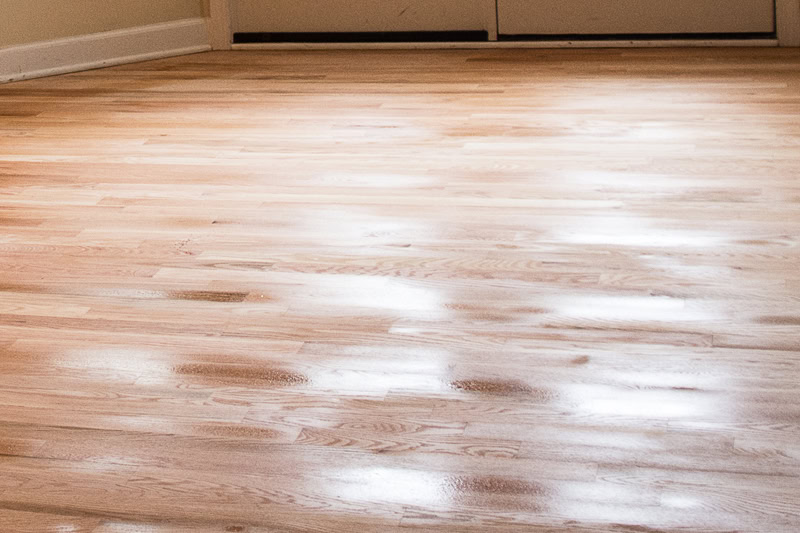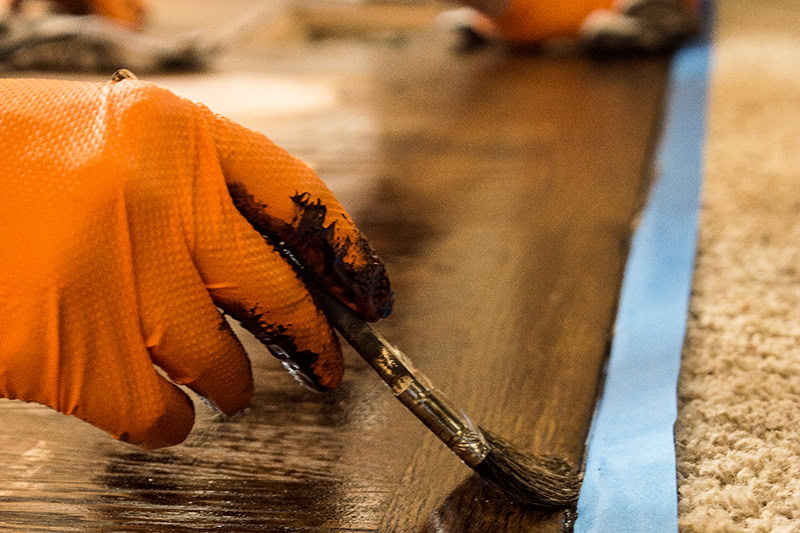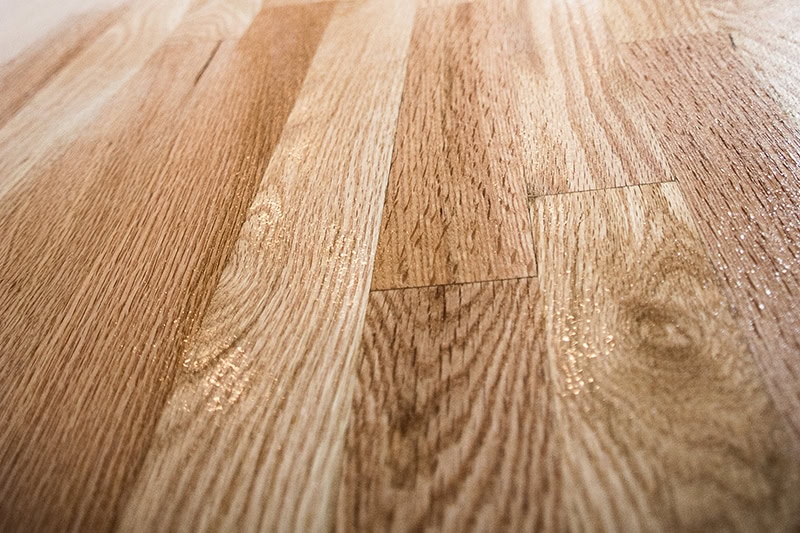What is Water Popping and Why Do It?
Water popping is a technique used during the hardwood floor refinishing process to open up the grain of the wood. It’s done prior to staining (changing the color of the floor) for the three main reasons we’ll discuss below.
 It involves lightly misting the sanded wood surface with a small amount of water to raise, or ‘pop’, the grain. As the water penetrates the exposed wood fibers, it causes them to expand and rise. This creates an ideal surface for the colored stain pigments to adhere to.
It involves lightly misting the sanded wood surface with a small amount of water to raise, or ‘pop’, the grain. As the water penetrates the exposed wood fibers, it causes them to expand and rise. This creates an ideal surface for the colored stain pigments to adhere to.
 This allows for the following benefits…
This allows for the following benefits…


 It involves lightly misting the sanded wood surface with a small amount of water to raise, or ‘pop’, the grain. As the water penetrates the exposed wood fibers, it causes them to expand and rise. This creates an ideal surface for the colored stain pigments to adhere to.
It involves lightly misting the sanded wood surface with a small amount of water to raise, or ‘pop’, the grain. As the water penetrates the exposed wood fibers, it causes them to expand and rise. This creates an ideal surface for the colored stain pigments to adhere to.
Why Water Popping Is Needed
After multiple passes of sanding with multiple sanding machines, with higher grits of sandpaper each time, a wood floor becomes very smooth. A floor in this state has very closed grain. This makes it difficult for the stain pigments to penetrate into the wood. By opening the grain with water, it makes the floor porous again, ready for the stain to properly absorb into the wood. This allows for the following benefits…
This allows for the following benefits…
The 3 Advantages of Water Popping
- It allows stain to be applied more evenly across the floor.Water popping ensures the grain is raised uniformly across the entire hardwood floor. Certain species of wood like maple, hickory and pine (as shown in the photo below) can look blotchy when stained. Water-popping allows stains to penetrate and absorb evenly, minimizing any blotchy or spotty areas that can happen with non-water popped stained floors. It will also mute the contrast between soft and hard grains in wood types like oak flooring.
- It helps remove micro sanding marks.Because water popping raises the grain, it helps blend the multiple sanding patterns made from various sanding machines and eliminates any remaining micro sanding marks. Without popping the grain, these sanding marks would show up darker, and more obvious, when the floor is stained.
- It allows dark stained floors to have darker and deeper shades.When wood floors are properly water popped before staining, the resulting finish takes on much greater vibrancy and depth. The raised grain allows stain pigments to fully absorb and saturate the wood, amplifying the color intensity for a bold, luxurious look.

The Risks of Water Popping
- The biggest risk is not covering the entire floor thoroughly and evenly. You can’t have sections soaking wet and others slightly damp. If you miss a spot, or don’t cover it evenly, it will be VERY obvious after the stain is applied. Because that spot still has closed grain, versus the open grain in the rest of the hardwood floor, it will be much lighter once stained. The only option will be to re-sand the floor and water pop again.
- There's also the risk that if too much water is applied or it's not given enough drying time before finish application, you could be setting the stage for serious wood floor problems like cupping, crowning, or even more extreme moisture damage.
- And the last risk, which is a big one, is once a hardwood floor has been water-popped, it is extremely delicate. The photo below shows a freshly water popped oak floor. Notice how delicate the raised grain looks. Because of this, water popped wood floor needs to be walked on extremely carefully, in socks only, to avoid damage. Any scuff mark from a hard shoe sole, or a mark from a dropped tool, will show up clear as day in the stained floor.

The Water Popping Process
Preparing for water popping starts with sanding the existing hardwood floor down to bare wood fusing low grit papers (36-50 grit) up to at least 80-100 grit. It needs to be in ready-to-coat condition, as if you were about to apply a finish coat. Then the raw hardwood floor is thoroughly vacuumed and wiped with a microfibre cloth to remove any specs of dust or debris. The floor is then ready to be water popped. It can be done in multiple ways. The first methods is by using a hand-pumped garden sprayer and misting the floor. The second is applying water by hand with a rag and a bucket of water. Both methods work well. With either one, just enough water is used to raise the grain, without over-wetting and risking moisture damage. The freshly popped floor then needs to be 100% dry before it can be stained.Best Practices for Water Popping
- To avoid issues, it's crucial to test the wood's moisture content with a professional grade moisture meter (shown below) before and after the process. Once it’s back to its pre-popped moisture reading, you know it’s ready for staining.
- Pure, clean water should always be used. For some types of wood, alternative methods like using water-based wood conditioners or alcohol may be appropriate instead of traditional water popping.
- We always suggest testing your hardwood floor to see how it reacts and what it looks like stained after water popping. Water popping results can vary with different types of wood. It’s much easier to do a small test area than commit to the entire floor and then realize you’ve made a mistake.


